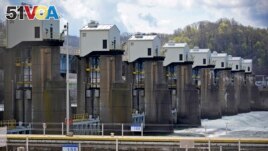27 March 2022
As the United States pushes to use more low-carbon energy, there has been a recent improvement in relations between the hydropower industry and some environmental groups.
The recent compromises are found in President Joe Biden's infrastructure law, which puts $2.5 billion toward projects including dam removals as well as improvements to existing structures for hydropower and energy storage.
Ted Illston of American Rivers, a group that has pushed for dam removals on environmental grounds, recently told the Associated Press that the group recognizes "that (hydropower) is probably going to play some role in the transition. It's certainly better than coal."

The Emsworth Dam and Lock are seen on the Ohio River in Emsworth, Pa., April 9, 2021. As the U.S. pushes to use more low-carbon energy, some hydropower companies see an opportunity to expand hydropower generation while minimizing environmental harm. (AP /Gene J. Puskar, File)
Hydropower in the United States
Hydropower uses flowing water to move turbines connected to generators. It is the oldest and second-largest sort of renewable energy in the U.S. after wind power. In 2020, it accounted for roughly 7 percent of the electricity generated in the country.
The industry has not received as much federal money as wind and solar, but sees room for growth. Of the 90,000 dams in the country, about 2,500 produce power. Non-powered dams could produce enough power for 9 to 12 million homes, said an estimate by the Electric Power Supply Association based on federal data from 2012.
In southwestern Pennsylvania, Rye Development, a Boston-based hydropower company, is adding turbines to eight dams to generate electricity. The company says the improved structures will limit damage to the rivers' water quality and fish.
Rye is among the companies that sees an opportunity to expand hydropower production at existing dams while working to minimize environmental harms.
Part of the difficulty is that most dams in the U.S. were built more than fifty years ago.
The risk of dam collapses has led to increased dam removals or demolitions in recent years, with more than 40 percent of the country's dam removals in the past century happening in the last ten years.
Last month, federal officials moved a step closer to approving what would be the largest dam demolition in U.S. history. Removal of the four hydroelectric dams on the Klamath River near the Oregon-California border would help save the river's salmon and other fish species that cannot reach breeding areas because of the structures.
Ongoing debates
Despite some recent improvements in relations between the hydropower industry and environmental groups, there are still disagreements. On Maine's Kennebec River, environmental groups and state environmental agencies are pushing for the removal of four hydropower dams that block endangered Atlantic salmon from reaching key areas. The dams make about 5 percent of the state's renewable energy.
Shannon Ames of the Low Impact Hydropower Institute said, "It's very easy for individual river systems to get lost in the message of climate change and the need for renewable energy."
With drought affecting hydropower production in America's West, the industry has a more direct path to growth in eastern states.
In Pennsylvania, Rye met with the Low Impact Hydropower Institute early in its process and is among a small number of companies seeking certification from the group.
To get certified, companies must show their structures meet protections for endangered species. The group says its environmental requirements are often stricter than state or federal rules.
I'm John Russell.
Suman Naishadham reported on this story for the Associated Press. John Russell adapted it for VOA Learning English.
____________________________________________________________________
Words in This Story
infrastructure – n. the basic equipment and structures (such as roads and bridges) that are needed for a country, region, or organization to function properly
transition – n. a change from one state or condition to another
turbine – n. an engine that has a part with blades that are caused to spin by pressure from water, steam, or air
species – n. biology : a group of animals or plants that are similar and can produce young animals or plants : a group of related animals or plants that is smaller than a genus
drought – n. a long period of time during which there is very little or no rain
certification – n. official approval to do something professionally or legally